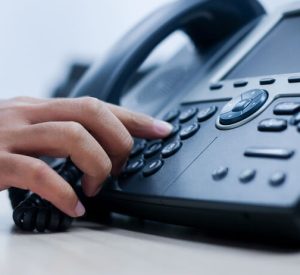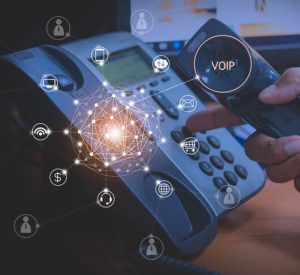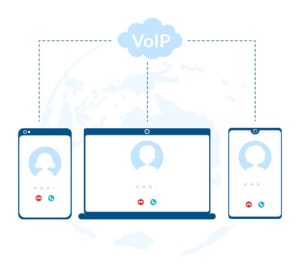Faxing with VoIP is quite tricky, sound signals are transmitted as data packets, often encoded as digital codecs for even basic audio formats like mp3, mp4, wmv, wav or such. Clearly, the analog circuitry isn’t equipped to handle these signals. Equally, digital transmission networks compress the analog signals with specific codecs meant for secure transmission without hogging the bandwidth. However, your existing faxing mechanism can be made compatible with VoIP.
As explained above, the first step is to make your analog devices internet friendly, by using a VoIP gateway for their operation, either leveraging basic VoIP or SIP Trunking. Both protocols would come with custom devices to compress the analog signals into digital codecs and a software controlled interface to monitor or administer the functionalities.
Next, you need an Analog Telephone Adapter (ATA) with T38 capabilities. Telephone and audio only functions can be handled by T.1 protocol of VoIP. For fax or digital packets of visual information or data to sound information to travel over digital channels, it needs to comply with the T.38 protocol. This is merely done to ensure signal fidelity, exclusive bandwidth frequencies are not interfered with and ensuring smooth electronic transfer of fax information.
So .. while traditional PSTN faxing was: Fax machine → Phone line → Fax machine, VoIP faxing is: Computer → Phone line → Fax machine or Fax machine → Phone line → Computer.
VoIP faxing has the same benefits as VoIP itself:
- wider bandwidth to send in large amounts of information, including concurrent transmission of many documents
- greater mobility, without any hardware reliance, to move and transfer documents over the web interface
- low cost
- faster transmission times (especially with broadband or high speed internet)
- better security when sent to specific email IDs or inboxes than shared legacy fax machines.
Needless to say, it suffers from similar drawbacks of latency, transmission delay in case of intermittent connectivity and needing the computer and the protocol software to be up and running for the entire duration of communication.
It’s important to note here that barring some very specific legal needs like signatures, faxing doesn’t offer any benefit over now-popular modes of document transfer over the internet like scanned attachments over email, instant messaging applications or web hosting services. However, the simplicity of operation (putting a document in the fax machine, dialing a a number and starting transmission) means they remain popular in office spaces or small business set ups.
Is Faxing Over VoIP the same thing as IP fax?
The names can be confusing but both are vastly different technologies. IP fax transmits data over an office intranet (typically a LAN/WAN infrastructure). The most common set up is a central multi-functional device (printer/scanner/fax all-in-one unit) which uses the local network to send documents from IP address of one computer or connected device to another. This helps in minimizing transmission fee. Increasingly however, adoption of instant messaging and communication suites like Slack are rendering this method of sending documents obsolete. T.38 is a commonly used and recommended transmission standard used for IP fax. But the IP faxing doesn’t use the email server or any other dedicated office resource, instead letting the multi-functional device to relay forward to the required IP of the destination machine.
Why not simply fax over email?
Not the first time this has been thought of! A lesser known standard called T.37 was developed (known commonly as iFax) to use email servers for faxing. However, the reliance on a T.37 converter for every computer or internet enabled device with emailing capability turned out to be a bigger adoption hurdle (for now, at any rate!). It can still be used with a fax gateway for analog fax machines but hasn’t quite caught on yet.
How to Setup My Fax Machine for VoIP Fax Service?
Assuming you have already acquired the VoIP Gateway and ATA with T.38 adequacy – there are a few more settings to tinker with before you can commence facsimile transmission of documents from your analog fax device or multi-functional unit over the VoIP connection.
Switching from G729 to G711: Typically, audio compression algorithm uses the G729 standard and that’s often the default configuration of a VoIP enabled unit. Make sure you switch it to G711 (or the non compressed codec) mode to avoid the fax from failing. The ‘Bandwidth Saver’ setting or any similar manufacturer verbiage on the device refers to similar compression standards. If you aren’t confident, call the provider to get it switched.
Reduce transmission speed. A lower bits per second (bps) BAUD rate is conducive to faxing (which carries a lot more information) than a compressed audio signal. It’s preferable to go as low as 7200 or at most 9600 bps for the BAUD rate setting of your fax machine. If connection problems over limited bandwidth persist, change the resolution setting to standard (the default is fine or super fine), to limit the data packets being sent over the network.
Check with a direct connection – It helps to ensure your communication channel is free of clutter by at least once connecting the internet enabled device with the faxing unit directly. Multi-functional units often have ancillary devices like called IDs, answering machines or even splitters for shared PBX uses which may interfere with faxing. Similarly, clearing any stutter tones or notification/ alerting tones from your unit may help. Some vendors have automatic settings to notify about voicemails, transcriptions etc. but they may end up confusing the signals of the faxing data audio.
Disable Error correction mode (ECM), often a default setting on many fax machines.
Like setting up your new Wi-Fi modem, it may take a few tries and eliminating the surge protectors or such intermediate devices to catch the raw signals first. Once you have established the device endpoints and that they are all ‘talking’ to each other over the required protocol, you can always add the splitters and ethernet cables.







